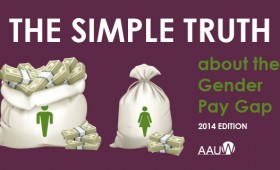The Simple Truth about the Gender Pay Gap (2014)
< < Go Back
You’ve probably heard that men are paid more than women are paid over their lifetimes. But what does that mean? Are women paid less because they choose lower-paying jobs? Is it because more women work part time than men do? Or is it because women tend to be the primary caregivers for their children?
AAUW’s The Simple Truth about the Gender Pay Gap succinctly addresses these issues by going beyond the widely reported 77 percent statistic. The report explains the pay gap in the United States; how it affects women of all ages, races, and education levels; and what you can do to close it.
• The pay gap hasn’t budged in a decade.
In 2012, as in 2002, among full-time, year-round workers, women were paid 77 percent of what men were paid.
• Women in every state experience the pay gap, but some states are worse than others.
The best place in the United States for pay equity is Washington, D.C., where women were paid 90 percent of what men were paid in 2012. At the other end of the spectrum is Wyoming, the worst state in the country for pay equity, where women were paid just 64 percent of what men were paid.
• The pay gap is worse for women of color.
The gender pay gap affects all women, but for black and Hispanic women the pay shortfall is worse Asian American women’s salaries show the smallest gender pay gap, at 87 percent of white men’s earnings. Hispanic women’s salaries show the largest gap, at 53 percent of white men’s earnings. White men are used as a benchmark because they make up the largest demographic group in the labor force.
• Women face a pay gap in nearly every occupation.
From elementary and middle school teachers to computer programmers, women are paid less than men in female-dominated, gender-balanced, and male-dominated occupations.
• The pay gap grows with age.
Women typically earn about 90 percent of what men are paid until they hit 35. After that median earnings for women are typically 75–80 percent of what men are paid.
• While more education is an effective tool for increasing earnings, it is not an effective tool against the gender pay gap.
At every level of academic achievement, women’s median earnings are less than men’s earnings, and in some cases, the gender pay gap is larger at higher levels of education. While education helps everyone, black and Hispanic women earn less than their white and Asian peers do, even when they have the same educational credentials.
• The pay gap also exists among women without children.
AAUW’s Graduating to a Pay Gap found that among full-time workers one year after college graduation — nearly all of whom were childless — women were paid just 82 percent of what their male counterparts were paid.
Here are changes that can help close the wage gap.
For companies
While some CEOs have been vocal in their commitment to paying workers fairly, American women can’t wait for trickle-down change. AAUW urges companies to conduct salary audits to proactively monitor and address gender-based pay differences. It’s just good business.
For individuals
Women can learn strategies to better negotiate for fair pay. Improved negotiation skills can help close the pay gap.
For policy makers
In the face of congressional gridlock, President Barack Obama can issue an executive order banning federal contractors from retaliating against workers who discuss their salaries or ask about pay practices, a move that could protect 22 percent of the nation’s workforce. Tell the president to act on equal pay now.
More From AAUW:




